The City of Belleville does not have a widespread program for insects or diseases in trees within the City. Chemical controls are mandated through the province's Cosmetic Pesticide Ban, which restricts the use of pesticides within the Ontario, with some exceptions. Our staff monitors trees throughout the City, with experienced staff that assist in diagnosing and recommended actions.
Tree pests commonly found in Ontario
|
Asian Long-Horned Beetle |
|
The Asian Long Horned Beetle (ALB) causes widespread mortality of poplar, willow, elm and maple trees. The beetle is a large black insect with white spots dashed irregularly on its wings. The distinctive long antennae that give the beetle its name are as long as The ALB is considered an invasive species in North America, where it is a serious threat to many deciduous hardwood trees. During the larval stage, the ALB bores deep into a tree's heartwood, where it feeds on the tree's nutrients. The tunneling damage within the cambium layer of the bark and eventually kills the tree. |
|
Aphids |
|
Aphids, also known as plant lice, have piercing/sucking mouth parts. Aphids infest new foliage on both annual and permanent plants, usually in spring or early summer. Aphids ingest the fluids from a tender leaf or stem tissue of the plant, depriving it of nutrients. They can also spread disease by moving from one plant to another. For severe infestations, an Urban Forestry representative will spray a strong jet of water or soap/water mix directly onto the affected area of the plant to wash the insects off. |
|
Carpenter Ants |
|
A carpenter ant's body is divided into three segments, with a very slim waist separating the upper body and lower body. Their antennae are bent and in sections. Male and female adults have wings at mating time. The mere presence of carpenter ants within a tree suggests premature rotting within the tree's core. |
|
Emerald Ash Borer |
|
The Emerald Ash Borer (EAB) is a highly destructive insect that |
|
Locust Plant Bugs |
|
|
|
Spongy Moth |
|
The Spongy Moth is a defoliating (feeding on leaves) |
|
Wasps and Hornets |
|
A wasp is a predatory, flying, stinging insect. A Pest Management Specialist will respond to all public concerns regarding wasp and hornet nests in City trees. A nest will only be destroyed if it is located on branches no higher than 5 metres (16 feet) above the ground. |
Tree diseases commonly found in Ontario
|
Apple Scab and Rust |
|
Apple Scab is one of the most common diseases of apple and flowering |
|
Dutch Elm Disease |
|
Dutch Elm Disease (DED) is often confused with other tree
|
|
Leaf Scorch |
|
|
|
Powdery Mildew |
|
|
|
Tar Spot |
|
|
Emerald Ash Borer Mitigation
The Parks and Open Space section, in 2012, identified 450 Ash (Fraxinus) species worthy of protection within the parks and began an investment in an attempt to mitigate the death caused by the Emerald Ash Borer.
Each year, approximately 225 trees are injected with a biological product which hampers the development of the pest within the cambium layer of the bark. The product is a synthetic insecticide, produced from the Neem Tree seed extracts (Azadiracta indica) and has a Chemical residual life span of two years. These seed extracts have been used for centuries to control insects and is different from Neem Oil. The other benefit to this product is that is NOT a Neonicotinoid pesticide, linked to effect the bee population in North America. There are local tree care professionals that can provide this service for trees on private property.
More Information
For more information on tree pests and diseases:


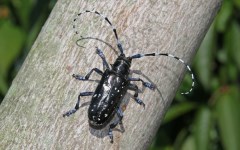 the body in females and almost twice the body length in males.
the body in females and almost twice the body length in males.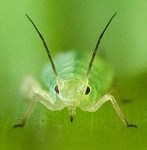
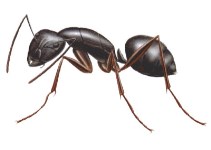 The red carpenter ant and the black carpenter ant are two of the most common types found in Canada. The red carpenter ant has a dark brownish-black body, with a reddish-brown upper body. The black carpenter ant is dark brownish-black all over.
The red carpenter ant and the black carpenter ant are two of the most common types found in Canada. The red carpenter ant has a dark brownish-black body, with a reddish-brown upper body. The black carpenter ant is dark brownish-black all over.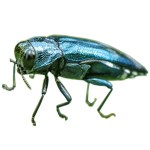 attacks and kills ash trees. Native to eastern Asia, EAB was first discovered in Windsor, Ontario, and Detroit, Michigan, in 2002. In 2008, the Canadian Food Inspection Agency (CFIA) confirmed the presence of EAB in Brampton and other neighbouring municipalities.
attacks and kills ash trees. Native to eastern Asia, EAB was first discovered in Windsor, Ontario, and Detroit, Michigan, in 2002. In 2008, the Canadian Food Inspection Agency (CFIA) confirmed the presence of EAB in Brampton and other neighbouring municipalities.  Locust Plant Bugs feed on the developing buds and leaves of a plant. They use a “lacerate and flush” feeding style that causes a lot of damage to the feeding site, which often destroys young leaves and buds. Older leaves may survive, but show discoloration and deformation of developing foliage due to localized necrosis around feeding points.
Locust Plant Bugs feed on the developing buds and leaves of a plant. They use a “lacerate and flush” feeding style that causes a lot of damage to the feeding site, which often destroys young leaves and buds. Older leaves may survive, but show discoloration and deformation of developing foliage due to localized necrosis around feeding points.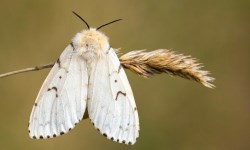 insect that is considered a major pest in North America. The caterpillar, or larva stage of the insect, eats the leaves of trees making them more susceptible to disease and damage from other insects.
insect that is considered a major pest in North America. The caterpillar, or larva stage of the insect, eats the leaves of trees making them more susceptible to disease and damage from other insects.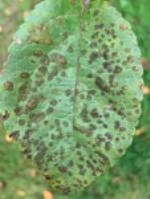 crabapple. The disease causes premature defoliation and a reduction in the number and quality of flowers the year following defoliation. Apple Scab first appears in early spring, especially on years with high levels of precipitation, as roughly circular, velvety, olive-green spots on both the upper and lower surfaces of leaves. The spots eventually turn dark-green to brown and develop a rough texture. Usually the fruiting bodies can be found on its alternative host, Junipers (Juniperus virginniana) commonly found throughout eastern Ontario.
crabapple. The disease causes premature defoliation and a reduction in the number and quality of flowers the year following defoliation. Apple Scab first appears in early spring, especially on years with high levels of precipitation, as roughly circular, velvety, olive-green spots on both the upper and lower surfaces of leaves. The spots eventually turn dark-green to brown and develop a rough texture. Usually the fruiting bodies can be found on its alternative host, Junipers (Juniperus virginniana) commonly found throughout eastern Ontario.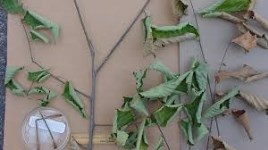 diseases such as Elm Yellows, Leaf Miner and Leaf Scorch. DED causes leaves to wilt and turn yellow, eventually changing to brown. Symptoms can be seen in the early summer, but may show any time in the growing season. Elms are used widely in urban forestry and along city streets. DED can affect entire rows of trees by transmission through the underground roots. Elm beetles are also attributed to the spreading of the disease.
diseases such as Elm Yellows, Leaf Miner and Leaf Scorch. DED causes leaves to wilt and turn yellow, eventually changing to brown. Symptoms can be seen in the early summer, but may show any time in the growing season. Elms are used widely in urban forestry and along city streets. DED can affect entire rows of trees by transmission through the underground roots. Elm beetles are also attributed to the spreading of the disease.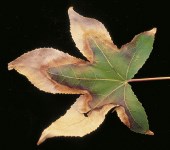 Leaf scorch may occur on any species of tree or shrub. Leaf scorch most often occurs following prolonged periods of dry or windy weather when the roots are unable to supply water to the foliage. It causes the browning of plant tissues and the darkening or yellowing of plant veins. In mild cases of leaf scorch, the leaves remain attached and little damage results. In more severe cases, plants may drop many of their leaves prematurely.
Leaf scorch may occur on any species of tree or shrub. Leaf scorch most often occurs following prolonged periods of dry or windy weather when the roots are unable to supply water to the foliage. It causes the browning of plant tissues and the darkening or yellowing of plant veins. In mild cases of leaf scorch, the leaves remain attached and little damage results. In more severe cases, plants may drop many of their leaves prematurely. Powdery Mildew is a fungal disease that affects a wide range of plants. It is one of the easiest diseases to spot, as its symptoms are quite distinctive. Infected plants display white powder-like spots on the leaves and stems. The lower leaves are the most affected, but the mildew can appear on any part of the plant. As the disease progresses, the spots get larger and thicker as massive numbers of spores form.
Powdery Mildew is a fungal disease that affects a wide range of plants. It is one of the easiest diseases to spot, as its symptoms are quite distinctive. Infected plants display white powder-like spots on the leaves and stems. The lower leaves are the most affected, but the mildew can appear on any part of the plant. As the disease progresses, the spots get larger and thicker as massive numbers of spores form.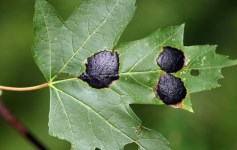 Tar spot cause round black, tar-like spots on infected leaves of Maples, which are not noticeable until late summer. Tar spots of maple are caused by fungus. The thickened black spots are fungal tissue called stroma. Red, silver, Norway and Manitoba Maples as well as others are affected by tar spot diseases.
Tar spot cause round black, tar-like spots on infected leaves of Maples, which are not noticeable until late summer. Tar spots of maple are caused by fungus. The thickened black spots are fungal tissue called stroma. Red, silver, Norway and Manitoba Maples as well as others are affected by tar spot diseases.